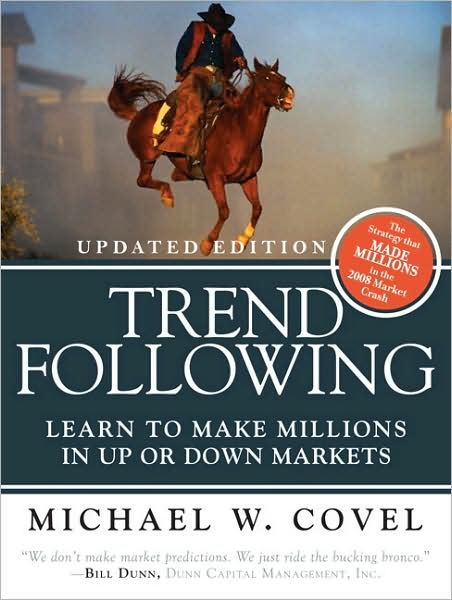Book Review: Trend Following (2)
I had a long debate inside myself before writing my book review last night.? I could have written the review recommending purchase of Trend Following, because it teaches a truth that often gets ignored in the market — following price momentum pays around 80% of the time.? As a value investor, that was a hard lesson for me to learn, but I accepted it once the evidence was clear enough.
Why I did not recommend the purchase of the book was more over tone and style.? Here are two examples: on pages 294-296, he discusses this paper that shows that Commodity Trading Advisor [CTA] performance is little better than T-bills.? There is one substantive complaint, and I agree with it, that the Sharpe ratio is a lousy measure of performance.? Most of the other arguments focus on the author’s affiliations — AIG Financial Products and Vanguard.? It is not valid to dismiss evidence off of the background of the individual.? Deal with his arguments.? So what if he worked for AIGFP?? That doesn’t make him liable for everything done there.? Same for Vanguard.? Merely because you work for Vanguard does not mean that you shill for mutual fund industry in everything that you do.
Humble Student of the Markets Cam Hui raises these objections in his comments to my piece last night.? I object to the ad hominem arguments of Mr. Covel.? If we must argue, let us argue on the basis of principle, and may the best side win.
Now, when Mr. Covel responded to me, it was also an ad hominem argument, tying me to Jim Cramer.? Now note, the first piece has disappeared from the internet, and I know not why.? Perhaps he gets that I am not a Jim Cramer clone.? To my readers I ask, how many of you think that I am like Jim Cramer in the way I advise?? I wrote a long series of articles on using investment advice to inoculate people against using stock tips from the media, partially because as Jim Cramer became more of a media phenomenon, his recommendations became worse.? He is at his best when he writes/says less, and gives you his considered opinion.? Investing and doing something sensational for the media do not mix.? That’s the conundrum of the value proposition for TSCM.
That said, Cramer does use price momentum as one of the factors in his stock selections.? He is generally a “trend follower.”? Cramer also is not a value investor.? Much as I appreciate him giving me a chance to write, we aren’t very similar.? That’s consistent with TSCM philosophy — they want a large range of views.? I wrote there for four years, and was one of their leading writers.? I rarely interacted directly with Cramer, instead, putting forth my own views, which did better (in my opinion).
I’m not Cramer, and he’s not me.? He just gave me a chance to write, for which many are grateful.? (I would tell you that he taught me how to trade corporate bonds, even though he has never traded corporates, but that would be a long story.)
Pressing on
This is not my last article on this topic.? I intend on continuing this discussion, to flesh out where I agree with Mr. Covel, because at many points I do agree, but there are complexities that need further elucidation.
The main areas I will cover in the future include:
- When does trend following fail?
- What other factors should we consider?
- What constitutes adequate proof that a strategy is superior?
I credit Michael Covel for commenting at my blog, and I will answer his question, but not today.? It is a valid question, but there are other questions that can be posed to him as well.? Let the debate commence on a fair basis.


